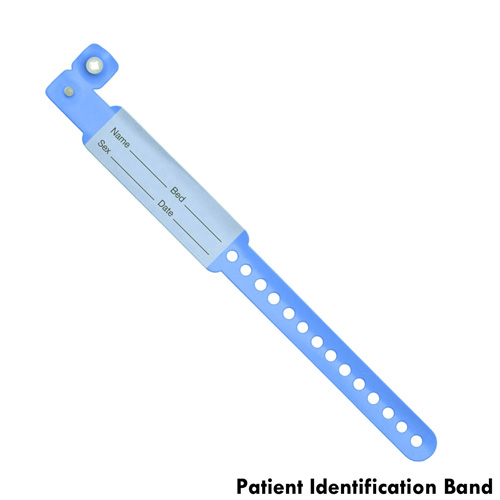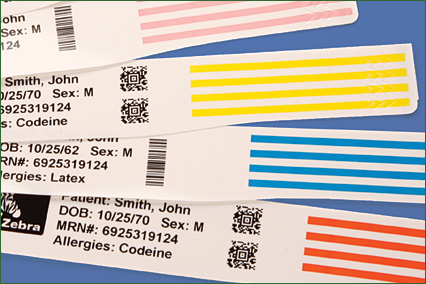Person Identification Bands: A Trick Tool for Improved Medical Accuracy
Patient identification bands stand for a vital element in the quest of clinical accuracy and patient security within health care settings. The true extent of their effect on patient results and general medical care top quality warrants better examination.

Significance of Patient Recognition
Individual identification is a crucial part of health care that makes sure the safety and security and precision of clinical treatment. Proper identification protocols are important to avoid clinical mistakes, which can cause negative patient outcomes, including wrong medication administration, misdiagnosis, or improper treatment strategies. The value of exact client recognition can not be overemphasized, as it offers as the structure for efficient communication among doctor.
In atmospheres where multiple patients are getting treatment concurrently, the threat of identification complication rises. Applying durable identification systems aids alleviate these threats and improves client safety and security. Patient Identification Band. Additionally, precise recognition adds to the integrity of clinical documents, making sure that client histories, allergies, and previous treatments are appropriately linked to the best person.
Furthermore, conformity with governing standards and certification needs frequently mandates strict person recognition protocols, cultivating a culture of accountability and quality treatment. Ultimately, the value of patient recognition transcends simple management jobs; it is an essential facet of delivering top notch healthcare that focuses on patient safety and security and improves scientific outcomes. Spending in reliable identification techniques is not simply useful-- it's essential in today's complex healthcare landscape.
Sorts Of Patient Recognition Bands
In medical care settings, numerous kinds of individual identification bands are utilized to make certain exact identification and improve safety. These bands function as an essential tool in preventing medical errors connected to person misidentification.
The most typical kind is the standard wristband, commonly constructed from resilient plastic and published with the patient's name, date of birth, and an one-of-a-kind recognition number. These wristbands are usually color-coded to communicate certain details, such as allergic reactions or various other medical conditions.
One more type is the barcode wristband, which incorporates a scannable barcode connected to the patient's digital health document. This innovation permits for efficient data access and verification during medication management and other clinical procedures.
Additionally, RFID (Superhigh Frequency Recognition) bands are ending up being significantly prominent. These bands can connect wirelessly with healthcare facility systems, enabling real-time tracking and recognition of people, therefore enhancing and enhancing process client safety.

Benefits for Doctor
Using client identification bands supplies significant advantages for doctor, improving both functional performance and individual security. These bands work as an essential device in simplifying patient management procedures (Patient Identification Band). By making certain accurate identification, medical care carriers can reduce the danger of administrative mistakes, such as mislabeling samples or misdirecting treatments, which can lead to costly hold-ups and complications
In addition, person recognition bands assist in seamless communication amongst the medical care group. With standard and conveniently available individual details, carriers can make educated choices rapidly, improving overall operations. This effectiveness is specifically crucial in high-pressure atmospheres such as emergency divisions, where time-sensitive treatments are vital.
The implementation of identification bands additionally supports compliance with regulative criteria and best methods, therefore lessening the risk of legal effects stemming from recognition mistakes. The use of these bands enhances data accuracy in electronic health and wellness records, leading to much better treatment coordination and continuity.
Influence On Client Security
Accurate person recognition is a foundation of healthcare safety, substantially decreasing the likelihood of mistakes that can jeopardize client well-being. The use of patient identification bands is important great post to read in guaranteeing that find out this here each individual obtains the right treatment, drugs, and treatments. These bands act as a reputable recommendation point for health care professionals, lessening the danger of misidentification, which can result in significant consequences such as wrong medication administration or surgical errors.
The application of standardized person recognition bands adds to a culture of security within medical care setups. By providing clear, easily understandable details, these bands help to enhance the importance of validating Find Out More patient identity at every phase of care. They assist in communication amongst team participants, making certain that everybody included in a client's care is mindful of their details needs and needs.
On top of that, utilizing client recognition bands can boost the accuracy of electronic health records, even more minimizing the capacity for mistakes - Patient Identification Band. By focusing on client safety via efficient identification techniques, doctor can promote depend on and confidence among people, ultimately causing better clinical end results and enhanced individual complete satisfaction. The effect of proper client recognition can not be overemphasized; it is an essential element of premium healthcare distribution
Ideal Practices for Execution
Effective application of patient recognition bands is vital for improving person safety and security and reducing errors in health care settings. To accomplish this, health care companies must adopt several ideal methods. First, staff training is crucial; all team participants must comprehend the value of exact client recognition and the procedures for band application. Regular training sessions and refresher course programs can ensure continuous conformity.
2nd, the design of the identification bands must focus on visibility and longevity. Bands need to be simple to review, include essential client details, and withstand day-to-day wear. Making use of color-coding can further enhance quick recognition.


Third, integrating digital health and wellness records (EHR) with identification band systems can streamline operations. Automated notifies for inconsistencies in patient identification can stop potential mistakes before they occur.
Lastly, carrying out regular audits and responses sessions will certainly help identify locations for enhancement. Engaging staff in these conversations cultivates a culture of safety and security and responsibility.
Final Thought
In final thought, person identification bands play an important duty in enhancing clinical precision and ensuring patient safety and security within healthcare systems. Taking on finest methods for execution cultivates a society of safety, ultimately leading to improved individual outcomes and better count on in healthcare solutions.
Patient recognition bands stand for an essential part in the quest of clinical accuracy and client safety and security within medical care environments.Utilizing client recognition bands supplies considerable benefits for medical care service providers, improving both operational effectiveness and client safety. By prioritizing person safety with reliable identification practices, health care suppliers can cultivate depend on and confidence amongst patients, eventually leading to much better medical end results and improved client complete satisfaction.Efficient execution of person identification bands is critical for boosting person safety and security and reducing errors in healthcare settings.In final thought, individual identification bands play an essential function in boosting medical precision and guaranteeing person safety and security within health care systems.